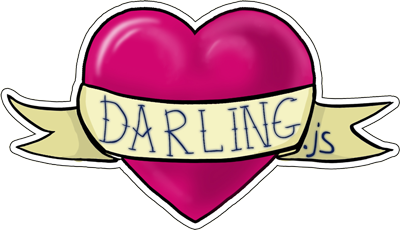darlingjs 


Lightweight entity, component, system based game engine. With flexible architecture. Decupled from any dependecy. So all interaction with Box2D, Render system, Particle System and so on put in pluggable modules. Use fluent API Crafty.js, jQuery like.
Support
Examples
Quick Start
Creating the World
Create the World for Box2D experiments
var world = darlingjs.world('myGame', [
//inject some modules
//get 2D components
'ngFlatland',
//get Common Physics components
'ngPhysics',
//get Box2D implementation of Physics components
'ngBox2DEmscripten'
], {
fps: 60
});
DarlingJS is lightweight framework so it's decoupled from any rendering, physics, sound, assets and so on libraries. And it possible to develop on pure javascript with your own simulation systems.
Every darlingjs modules start with prefix 'ng', for example: 'ngPhysics'.
Add systems
add physics simulation system
world.$add('ngBox2DSystem', {
//define gravity of box2d world
gravity: {
x: 0,
y: 9.8
},
//define properties of physics simulation
velocityIterations: 3,
positionIterations: 3
});
add view port system for definition 2D camera position
world.$add('ng2DViewPort', {
//centor of the camera
lookAt: {
x: width / 2, y: height / 2
},
//size of the camera view
width: width,
height: height
});
add box2d debug draw visualization
world.$add('ngBox2DDebugDraw', {
//target div/convas element. For div element automaticaly create canvas element and place into the div
domID: 'gameView',
//size of canvas
width: width, height: height
});
add drugging support system.
world.$add('ngBox2DDraggable', {
//target div/convas element
domId: 'gameView',
//width, height of it
width: width, height: height
});
Create Entity
Create entity of draggable box and add it to the world
darlingjs.$e('box', {
//define position
ng2D: {
x: 0.0,
y: 0.0
},
//define size of
ng2DSize: {
width: 10.0,
height: 10.0
},
//mark entity as physics object
ngPhysics: {},
//mark entity as draggable object
ngDraggable: {}
});
Here is alternative notation: When you have a lot of components in default state, it useful to count of components by array
darlingjs.$e('box', ['ng2D', 'ng2DSize', 'ngPhysics', 'ngDraggable']}
Start The Game
To run update of game the world 60 times in second just use:
world.$start();
One frame emulation:
world.$update(1/60);
Create custom system with custom component
Create system that automaticaly increase life of any entities with 'ngLife' and 'lifeHealer' components. So you if you want to heal some entity you can just add 'lifeHealer' component to it.
Usage
//start healing entity
entity.$add('healer');
//stop healing entity
entity.$remove('healer');
Define component and system
//define healer component
world.$c('healer', {
power: 0.1,
maxLife: 100.0
});
//define and add healer system to the game world
//!ATTENTION! in next verstion $node and $nodes will be changed to the $entity and $entities
world.$s('healerSystem', {
//apply to components:
$require: ['ngLife', 'healer'],
//iterate each frame for each entity
$update: ['$node', function($node) {
if ($node.ngLife.life <= this.healer.maxLife) {
//heals entity
$node.ngLife.life += this.healer.power;
} else {
//stop healing when life reach of maxLife
$node.$remove('healer');
}
}]
});
Inspired by
- AngularJs - dependecy injections;
- Ash - component, entity, system architecture;
- CraftyJS - fluent api;
Pluggable darlingjs Modules
- 2D Renderering uses pixi.js;
- Physics uses emscripted box2d 2.2.1 or box2dweb 2.1a;
- Performance (FPS/Mem) metter uses Stats.js;
- Flatland (2D components);
- Generators (systems of procedural generation of infinity world);
- Particles (systems and components for emitting particles);
- Player (components for store player state: score, life);
Comming soon Modules
- Advanced Particle System;
- AI
- FlashJS, EaselJS Rendering;
- Sound;
- and so on.
Example of Usage
Game Engine now in active developing and here is just proof of concept.
var world = darlingjs.world('myGame', ['ngModule', 'flatWorld'], {
fps: 60
});
world.$add('ngDOMSystem', { targetId: 'gameID' });
world.$add('ngFlatControlSystem');
world.$add('ng2DCollisionSystem');
world.$e('player', [
'ngDOM', { color: 'rgb(255,0,0)' },
'ng2D', {x : 0, y: 50},
'ngControl',
'ngCollision'
]);
for (var i = 0, l = 10; i < l; i++) {
var fixed = Math.random() > 0.5;
world.$e('obstacle_' + i, [
'ngDOM', { color: fixed?'rgb(0, 255, 0)':'rgb(200, 200, 0)'},
'ng2D', {x : 10 + 80 * Math.random(), y: 10 + 80 * Math.random()},
'ngCollision', {fixed: fixed}
]);
}
world.$e('goblin', [
'ngDOM', { color: 'rgb(255,0,0)' },
'ng2D', {x : 99, y: 50},
'ngRamble', {frame: {
left: 50, right: 99,
top: 0, bottom: 99
}},
'ngScan', {
radius: 3,
target: 'ngPlayer',
switchTo: {
e:'ngAttack',
params: {
switchTo:'ngRamble'
}
}
},
'ngCollision'
]);
world.$start();
Create Module
var ngModule = darlingjs.module('ngModule');
ngModule.$c('ngCollision', {
fixed: false
});
ngModule.$c('ngScan', {
target: 'ngPlayer'
});
ngModule.$c('ngRamble', {
frame: {
left: 0, right: 0,
top: 0, bottom: 0
}
});
ngModule.$c('ngPlayer', {
});
ngModule.$c('ngDOM', {
color: 'rgb(255,0,0)'
});
ngModule.$c('ng2D', {
x: 0.0,
y: 0.0,
width: 10.0,
height: 10.0
});
ngModule.$c('ngControl', {
speed: 10,
keys:{ UP_ARROW: -90, DOWN_ARROW: 90, RIGHT_ARROW: 0, LEFT_ARROW: 180}
});
ngModule.$system('ng2DRamble', {
$require: ['ngRamble', 'ng2D'],
_updateTarget: function($node) {
$node._target = {
x: 4 * Math.random() - 2,
y: 4 * Math.random() - 2
};
$node._target = this._normalizePosition($node._target, $node.frame);
},
_normalizePosition: function(p, frame) {
if (p.x < frame.left) {
p.x = frame.left;
}
if (p.x > frame.right) {
p.x = frame.right;
}
if (p.y < frame.top) {
p.y = frame.top;
}
if (p.y > frame.bottom) {
p.y = frame.bottom;
}
},
_distanceSqr: function(p1, p2) {
var dx = p1.x - p2.x;
var dy = p1.y - p2.y;
return dx * dx + dy * dy;
},
$update: ['$node', function($node) {
if (!$node._target) {
this._updateTarget($node);
} else if (this._distanceSqr($node.ng2D, $node._target) < 1) {
this._updateTarget($node);
} else {
var dx = Math.abs($node._target.x - $node.ng2D.x);
var dy = Math.abs($node._target.y - $node.ng2D.y);
if (dx > dy) {
$node.ng2D.x+= $node._target.x > $node.ng2D.x?1:-1;
} else {
$node.ng2D.y+= $node._target.y > $node.ng2D.y?1:-1;
}
}
}]
})
ngModule.$system('ng2DCollisionSystem', {
$require: ['ngCollision', 'ng2D'],
_isLeftCollision: function(p1, p2) {
return false;
},
_isRightCollision: function(p1, p2) {
return false;
},
_isTopCollision: function(p1, p2) {
return false;
},
_isBottomCollision: function(p1, p2) {
return false;
},
$update: ['$nodes', function($nodes) {
//TODO brute-force. just push away after collision
for (var j = 0, lj = $nodes.length; j < lj; j++) {
for ( var i = 0, li = $nodes.length; i < li; i++) {
var node1p = $nodes[i].ng2D;
var node2p = $nodes[j].ng2D;
var node1Fixed = $nodes[i].ngCollision.fixed;
var node2Fixed = $nodes[j].ngCollision.fixed;
if (this._isLeftCollision(node1p, node2p)) {
//TODO shift nodes based on
node1Fixed, node2Fixed;
} else if (this._isRightCollision(node1p, node2p)) {
//TODO shift nodes based on
node1Fixed, node2Fixed;
} else if (this._isTopCollision(node1p, node2p)) {
//TODO shift nodes based on
node1Fixed, node2Fixed;
} else if (this._isBottomCollision(node1p, node2p)) {
//TODO shift nodes based on
node1Fixed, node2Fixed;
}
}
}
}]
});
ngModule.$system('ng2DScan', {
$require: ['ng2D', 'ngScan'],
$update : ['$nodes', function($nodes) {
//TODO brute-force. just push away after collision
for (var j = 0, lj = $nodes.length; j < lj; j++) {
for ( var i = 0, li = $nodes.length; i < li; i++) {
}
}
}]
})
ngModule.$system('ngControlSystem', {
$require: ['ng2D', 'ngControl'],
_targetElementID: 'game',
_target:null,
_actions: {},
_keyBinding: [],
_keyBind: function(keyId, action) {
this._keyBinding[keyId] = action;
this._actions[action] = false;
},
$added: function() {
this._keyBind(87, 'move-up');
this._keyBind(65, 'move-left');
this._keyBind(83, 'move-down');
this._keyBind(68, 'move-right');
this._target = document.getElementById(this._targetElementID);
var self = this;
this._target.addEventListener('keydown', function(e) {
var action = self._keyBinding[e.keyID];
if (action) {
self._actions[action] = true;
}
});
this._target.addEventListener('keyup', function(e) {
var action = self._keyBinding[e.keyID];
if (action) {
self._actions[action] = false;
}
});
},
_speed: {x:0.0, y:0.0},
_normalize: function(speed) {
//TODO : ...
},
$update: ['$node', '$time', '$world', function($node, $time, $world) {
var speed = this._speed;
if (this._actions['move-up']) {
speed.y = -1.0;
}
if (this._actions['move-down']) {
speed.y = +1.0;
}
if (this._actions['move-left']) {
speed.x = -1.0;
}
if (this._actions['move-right']) {
speed.x = +1.0;
}
this._normalize(speed);
$node.ng2D.x += speed.x * $time * $world.fps;
$node.ng2D.y += speed.y * $time * $world.fps;
}]
});
ngModule.$system('ngDOMSystem', {
_targetElementID: 'game',
_target: null,
_element: null,
_style: null,
$require: ['ngDOM', 'ng2D'],
$added: function() {
if (this.target === null && this.targetId !== null) {
this.target = document.getElementById(this.targetId);
}
},
$addNode: function($node) {
var element = document.createElement("div");
var style = element.style;
style.position = "absolute";
$node._style = style;
$node._element = element;
this._target.appendChild(element);
},
$removeNode: function($node) {
//TODO:
this._target.removeChild($node._element);
},
$update: ['$node', function($node) {
var style = $node._style;
style.left = $node.ng2D.x + 'px';
style.top = $node.ng2D.y + 'px';
}]
});
Copyrights
Logo by Alena Krevenets (Burenka) http://burenkaz.daportfolio.com/

